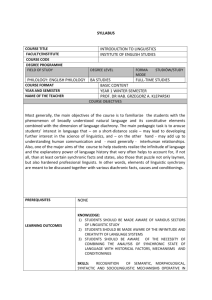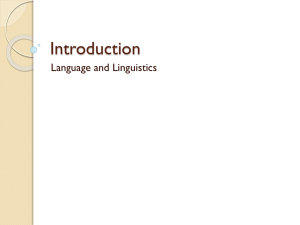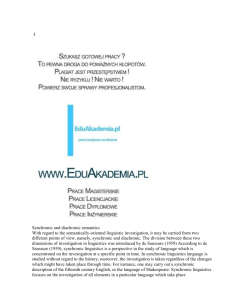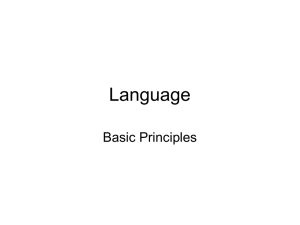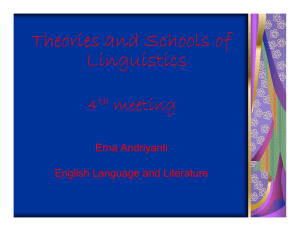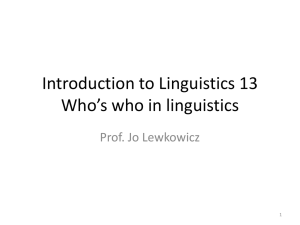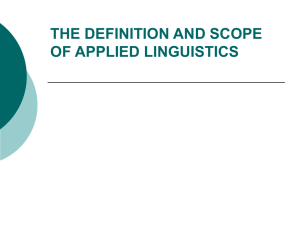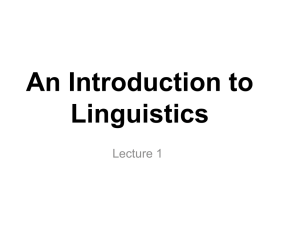语言学
advertisement
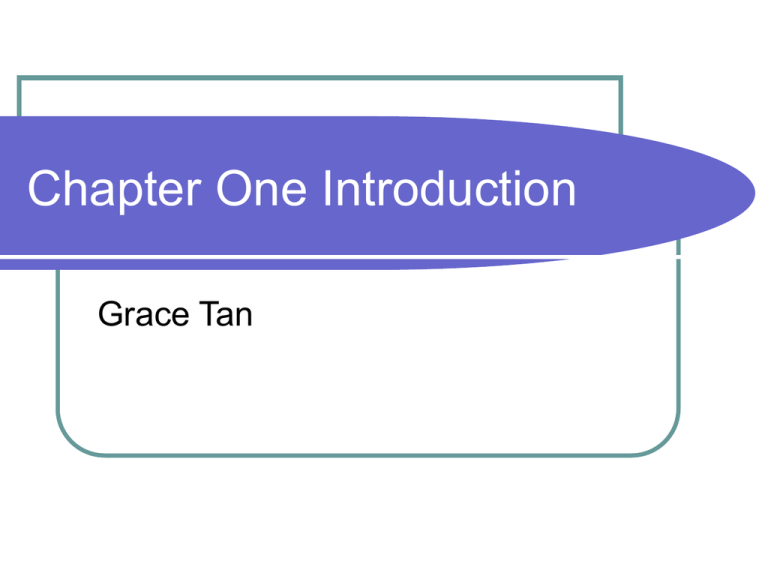
Chapter One Introduction Grace Tan I. Assignment-checking: What is language? What are the design features of language? What are the functions of language? How to distinguish the : Linguistics vs.traditional grammar Descriptive vs. prescriptive Synchronic vs. diachronic Langue vs.parole Competence vs.performance II.Introduction to New Contents 1.1 Why Study Language? Language is such an integral part of our life and humanity that too much about it has been taken for granted. 1.2 What is Language? Language is a system of arbitrary vocal symbols used for human communication. 1.3 Design Features of Language Arbitrariness Duality Creativity Interchangeability Displacement Specialization Cultural transmission 1.3.1 Arbitrariness The forms of linguistic signs bear no natural relationship to their meaning.—Saussure Father of modern linguistics 1) Arbitrariness between a morpheme and its meaning Onamatopoeia words are not arbitrary: 叮咚, 轰隆,叽里咕噜 The murmurous haunt of flies on summer eves. ---Ode to a Nightingale by John Keats Written ex vow vow myoww ba door sahee cuck-roo-coo bwack guwru guwrun dhun tik ting-ting 1. a cat 2.a horse 3.a slamming 4. a bell 5. a cock 6. a dog 7. a sheep 8. a clock 9. a pig 10. a duck 2) Arbitrariness at the syntactic level Systemic-functionalists (功能主义者): Language is not arbitrary at the syntactic level. A) He came in and sat down. B) He sat down and came in. C) He sat down after he came in. 3) Arbitrariness and conventionality The link between a linguistic sign and its meaning: Arbitrariness vs. Conventionality (creative) (laborious) Some compound words are not entirely arbitrary, e.g. type-writer, shoe-maker, air-conditioner, photocopy… Practice: You may be familiar with the following proverbs. How do you perceive them according to the arbitrariness and conventionality of language: The proof of the pudding is in the eating. Let sleeping dogs lie. You can’t make a silk purse out of a sow’s ear. Rome was not built in a day. When in Rome, do as the Romans do. All roads lead to Rome. 1.3.2 Duality Lower level---sounds (meaningless) • Higher level---meaning (larger units of meaning) Hierarchy of language Sounds ---syllables--- morphemes --- words --- phrases ---clauses -- sentences/utterances --texts/discourses 语言的双重性表现在两方面: 1. 用自身无意义的 语音构成 有意义的语 言单位 2. 用小单位构成大单位 1.3.3 Creativity/Productivity Language is resourceful because of its duality and recursiveness递归性 1) create new meanings: 2) Potential to create endless sentences EG: A red-eyed elephant is dancing on the hotel bed. Animals: limited and confined to a small set of message 1.3.4 Displacement Human languages enable their users to symbolize objects, events and concepts which are not present (in time and space) at the moment of communication. Time: Confucius (2550 years ago) Space: North Pole Animals: immediate stimulus control A dog cannot tell that its master will be home in a few days. 1.5 Functions of Language Language is above all, as any semiotic system, for communication. ---Roman Jakobson 1) Phatic function/Communion The social interaction of language Mrs. P sneezes violently. Mrs. Q: Bless you. Mrs. P: Thank you. 亲 Good morning, God bless you, Nice day, etc. 2) Directive function指令功能 Imperative sentences 3) Informative function Ideational function in functional grammar Declarative sentences Eg:Road closed. Please aim carefully. 4)Interrogative function 疑问功能 What time is it now? √ If Winter comes, can Spring be far behind? × 5) Expressive function 表达功能 Language is used to reveal the speaker′s attitudes and feelings. Eg: MY GOD! God, Damn it, What a sight, Wow, Ugh, Oh.我和我的小伙伴都惊呆了。 6) Evocative function 情感功能 Language is used to create certain feelings in the hearer. Jokes, ad, propaganda E.g.: Once god came up 2 me & granted me a wish. I asked 4 world peace. That's impossible, he said. Then I asked him 2 give u brains. He said, "Let me try world peace". 7) Performative function施为功能 It originates from the philosophical study of language represented by Austin and Searle, whose theory now forms the back-bone of pragmatics. Eg: I now declare the meeting open. I bet you two pounds it will rain tomorrow. 1) Linguistics vs.traditional grammar Linguistics describes language while traditional grammar aims to lay down rules of correctness. ② Linguists regard the spoken language as primary, not the written. ③ Traditional grammar is based on Latin and tries to impose the Latin categories and structures on other language while linguistics describes each language on its own merits. ① 2) Scope of linguistics microlinguistics Phonetics (语音学) Phonology (音系学) Morphology (形态学) Syntax (句法学) Semantics (语义学) Pragmatics (语用学) 3) Important distinctions in linguistics Descriptive vs. prescriptive Synchronic vs. diachronic Langue vs. Parole Competence vs. performance synatagmatic vs.paradigmatic relations Prescriptive vs. descriptive 1. describe and analyze the language people actually use--descriptive. 2. lay down rules for correct and standard behavior in using language---prescriptive. Eg: It is I. It is me. Synchronic共时性 vs. diachronic 历时性 1. The description of a language at some point of time in history is a synchronic study. 2. The description of a language as it changes through time is a diachronic study. Practice: 22. The following are some book titles of linguistics. Can you judge the synchronic and diachronic orientation just from the titles? English Examined: Two centuries of Comment on the Mother-Tongue. Protean Shape: A Study in Eighteenth-century Vocabulary and Usage. Pejorative Sense Development in English. The Categories and Types of Present-Day English Word-Formation. Language in the Inner City: Studies in the Black English Vernacular. Langue 语言vs. parole言语 Langue :abstract and stable Parole : it refers to the naturally occurring language events; varies from person to person, and from situation to situation. Competence语言能力 vs. performance语言行为 Competence is the knowledge you (subconsciously) possess about how to speak a language. Performance is your real world linguistic output. Performance may accurately reflect competence, but it also may include speech errors due to slips of the tongue or, as Chomsky points out in the quote above, external factors such as memory problems, etc. Eg: We swimmed in the ocean this weekend. Syntagmatic vs.paradigmatic relations 横组合 vs .纵聚合 Syntagmatic relations are relations between units present in the same sequence or construction, syntagmatically related elements form structures. Paradigmatic relations are relations between a unit and other units that can replace it in a given sequence. Paradigmatically related units form systems. The horizontal/linear vs.vertical relations III.Problem-solving IV. After-class assignments: 1.Review: 1)the definition, features, and main functions of language. 2)Exercises and discussion questions on P18. 2.Preview chapter two: Chapter 2 Previewing questions: 1.What does phonetics include? Why? 语音学涉及的 范围主要是哪些方面? 为什么? 2.How does linguist transcribe speech sounds?语音学 家是如何来描写语音的? 3.How to differ vowels and consonants? 元音和辅音有 什么区别? 4. How to tell phonetics from phonology? What are their basic units?语音学和音系学的主要差别在什么地 方? 它们分别以什么为分析基础单位? 5.What is the actual use of minimal pairs? 最小对立体 有什么实用功能? 6.What are the principal distinctive features of consonants?辅音的主要区别特征是什么? 7.How to structure syllables and how to tell open syllables from closed syllables? Use examples to illustrate this.如何划分音节并区分 开音节和闭音节?实例说明。 8.How do you understand intonation in Chinese? Is it a speech sound,phoneme or distinctive feature?你是怎样来看待汉语的声调 的? 声调到底是语音? 还是音位? 或者说是区别 特征?
